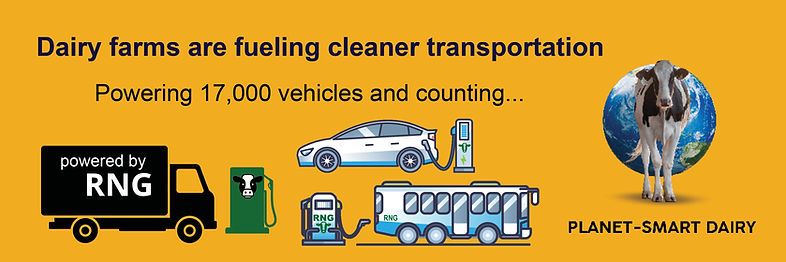
COW POWER
Cooling the Climate, Cleaning the Air
California dairy farms are capturing methane and creating clean, renewable energy.
More than 129 dairy farms in California currently have digesters operating. Another 100-plus digester projects are in the works, to soon be capturing methane from 259 dairy farms. Renewable energy created on California dairies is already helping power the state's clean-energy future, creating either renewable electricity, renewable natural gas, or hydrogen fuel.
-
Today, California dairy farms are generating enough renewable natural gas to fuel more than 3,706 transit buses or heavy-duty trucks.
-
At the same time, California dairy farms are also generating enough renewable electricity to power more than 13,502 electric vehicles.
-
In total, California dairy farms power more than 17,000 vehicles daily.
Equivalency calculations based on the average “UBUS” rate per CARB’s EMFAC 2021 emissions model and the average “LDA” rate per CARB’s EMFAC 2021 emissions model.

California dairy fuel is replacing diesel use.
Renewable Natural Gas (RNG) from California dairy farms is used in heavy duty trucks and buses, helping decrease NOx emissions from diesel fleets. The use of dairy RNG on local highways and roads is a significant opportunity to reduce air pollution today. It's already benefitting local communities, especially in the San Joaquin Valley.
California dairy farms are improving air quality.
Dairy digesters are also creating significant improvements to the local air quality by capturing and removing hydrogen sulfide (H2S). Without a digester, in the open lagoon manure management system, H2S oxidizes in the atmosphere to sulfur oxides (SOx), which further convert to sulfate particulate matter. Digester projects capture and eliminate the H2S, allowing for immediate and meaningful improvement in local air quality as well as significant improvements in odor management.
Dairy farmers in the San Joaquin Valley have been making air quality improvements for many years by replacing tractors, electrifying irrigation pumps, and other efforts, often incentivized by the District. The Electrified Dairy Feed Mixing Program is the latest example of this long-time partnership.
California dairy farms are electrifying and innovating.



